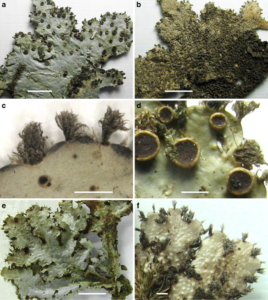Sticta subfilicinella B. Moncada, Coca & Lücking, in Ariyawansa et al., Fungal Diversity: 10.1007/s13225-015-0346-5, [112] (2015)
Index Fungorum number: IF551576; Facesoffunginumber: FoF00930
Etymology – Referring to the similarity and close relationship with Sticta filicinella.
Holotype – L.F. Coca 1110 (FAUC).
Diagnosis – Differing from Sticta filicinella in the absence of isidia.
Thallus epiphytic, corticolous. Primary photobiont a cyanobacterium(Nostoc). Basal stipe absent or indistinct. Thallus irregular to suborbicular, up to 5 cm across, moderately branched. Lobes laciniate to ligulate, ascendant, adjacent to imbricate, plane to canaliculate, with rounded, revolute tips; margins straight to sinuose; lobe internodes 4–10(−15) mm long and 4–10 mm broad. Upper surface even to shallowly scrobiculate-rugose, greenish grey when fresh and bluish to greenish grey in the herbarium, opaque to slightly glossy, glabrous, with abundant, irregular, cream-coloured maculae; cilia sparse to abundant, dark brown, up to 1 mm long. Vegetative propagules absent. Apothecia sparse, mostly submarginal,
substipitate, up to 1.5 mm diam. and 330μm high; disc orange; margin entire, cream-coloured to light yellowish. Excipulumup to 130μm broad; hymenium up to 160μm high; epithecium up to 5μm high, orange. Ascospores not observed. Medulla loose in surface view, cream-coloured, K+ yellow, C–, KC–, P–. Upper cortex paraplectenchymatous, 30– 45μm thick, with uniform layers; photobiont layer 25–35μm thick; medulla 50–120μm thick, with yellow-orange crystals; lower cortex paraplectenchymatous, 15–30μm thick. Lower surface undulate, cream-coloured to pale yellowish. Primary tomentum vein-like, thick, becoming sparse and thin towards the margin, spongy, dark brown, hairs 75–900μm long, forming fascicles of 12–20 unbranched, septate hyphae; secondary tomentum absent. Rhizines absent. Cyphellae abundant, 21–40 per cm2 towards the center and 100–200 per cm2 towards the margin, dispersed, angular-rounded, thelotremoid to urceolate with narrow pore, 0.1–0.25 mm diam., erumpent to prominent but remaining below the level of the tomentum, with involute, cream-coloured to pale yellowish, glabrous margin; basal membrane finely pubescent, with papillum per cell, cream-coloured to pale yellowish, K+ yellow, C–, KC–, P–. Pycnidia not observed. Secondary
chemistry – No substances detected by TLC but medulla and basal membrane of the cyphellae with dispersed, orangeyellow pigment granules in anatomical sections.
Material examined – COLOMBIA, Risaralda, Mun. Santuario, Tatamá National Natural Park, close to Monte Zancudo, 2600 m, 13 January 2011, L.F. Coca et al. 1110 (FAUC holotype; UDBC isotype); Caldas, Mun. Pacora, Filobonito trial, La Quinta section, 2123 m, 2010, L.F. Coca 177 (UDBC); Cundinamarca, Mun. Choachí, El Verjón, Matarredonda Ecological Park, 04° 34′ N, 74° 00′ W; 2900– 3220 m, 8 May 2010, B. Moncada 3060 (UDBC); Magdalena, Mun. Santa Marta, Sierra Nevada de Santa Marta, Alto Buritaca transect, 2500 m, August 1977, G. van Reenen & O. Rangel 269 (COL, U); Same locality, Buritaca transect,
2500 m, August 1977, O. Rangel et al. 711 (COL, U); Nariño, Mun. Piedrancha, La Planada, San Isidro, S of Ricaurte (Pasto to Tumaco road), 1750 m, 2 June 1993, H. Sipman et al. 32849 (B, COL); Risaralda, Mun. Santuario, Tatamá National Natural Park, Planes de San Rafael, trail after hut, 2400 m, 12 January 2011, L.F. Coca et al. 1079 (FAUC); same locality, close to Monte Zancudo, 2600 m, 13 January 2011, L.F. Coca et al. 1139, 1213, 1214 (FAUC).
Distribution and Ecology – Sticta subfilicinella is thus far known from the Colombian Andes, in the upper montane cloud forest zone between 1750 and 3220 m altitude. The species is typically found epiphytically in semi-exposed microsites.
Distribution and Ecology – Sticta subfilicinella is thus far known from the Colombian Andes, in the upper montane cloud forest zone between 1750 and 3220 m altitude. The species is typically found epiphytically in semi-exposed microsites.
Notes – This new species belongs in a group characterized by an exclusively cyanobacterial photobiont forming small, thin, fragile grey thalli (often both fresh and in the herbarium), with marginal cilia, the lower tomentum often vein-like, and small, thelotremoid cyphellae. The lower margin is usually glabrous. This group is related to Sticta tomentosa and allies (Moncada et al. 2014a, b; Fig. 62). Most similar to Sticta subfilicinella is S. filicinella (Nyl.) Zahlbr., which produces abundant isidia instead of apothecia (Lumbsch et al. 2011; Moncada 2012). Another similar species is the recently described S. venosa Lücking et al. from Ecuador (Lumbsch et al. 2011), which has broader lobes and like S. filicinella also produces isidia.

